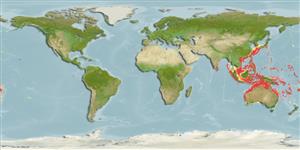Environment: milieu / climate zone / depth range / distribution range
Ökologie
seewasser demersal; tiefenbereich 4 - 390 m (Ref. 9824). Tropical
Eastern Indian Ocean and Western Pacific: Bay of Bengal to southern Japan, Taiwan, New Caledonia, and several areas of the Indo-Australian Archipelago (Ref. 9824).
Size / Gewicht / Alter
Maturity: Lm ? range ? - ? cm
Max length : 24.0 cm TL Männchen/unbestimmt; (Ref. 9824)
Rückenflossenstacheln (insgesamt) : 0; Rückenflossenweichstrahlen (insgesamt) : 100 - 114; Afterflossenstacheln: 0; Afterflossenweichstrahlen: 78 - 91. Mouth rather small, contained2. to 2.6 times in head length, maxillary extending to below the anterior margin or anterior 1/3 of lower eye. Gill rakers present on upper limb. Caudal fin with 2 simple rays on upper and lower margins. In the male, several anterior dorsal rays somewhat elongated.
Inhabits sandy substrates in coastal bays to deep offshore (Ref. 48637). Feeds on benthic animals.
Life cycle and mating behavior
Maturities | Fortpflanzung | Spawnings | Egg(s) | Fecundities | Larven
Masuda, H., K. Amaoka, C. Araga, T. Uyeno and T. Yoshino, 1984. The fishes of the Japanese Archipelago. Vol. 1. Tokai University Press, Tokyo, Japan. 437 p. (text). (Ref. 559)
IUCN Rote Liste Status (Ref. 130435)
Bedrohung für Menschen
Harmless
Nutzung durch Menschen
Fischereien: nicht kommerziell
Tools
Zusatzinformationen
Download XML
Internet Quellen
Estimates based on models
Preferred temperature (Ref.
123201): 16.4 - 27.8, mean 23.6 °C (based on 607 cells).
Phylogenetic diversity index (Ref.
82804): PD
50 = 0.5000 [Uniqueness, from 0.5 = low to 2.0 = high].
Bayesian length-weight: a=0.00912 (0.00408 - 0.02036), b=3.05 (2.87 - 3.23), in cm total length, based on LWR estimates for this (Sub)family-body shape (Ref.
93245).
Trophic level (Ref.
69278): 3.5 ±0.37 se; based on food items.
Widerstandsfähigkeit (Ref.
120179): mittel, Verdopplung der Population dauert 1,4 - 4,4 Jahre. (Preliminary K or Fecundity.).
Fishing Vulnerability (Ref.
59153): Low vulnerability (14 of 100).
